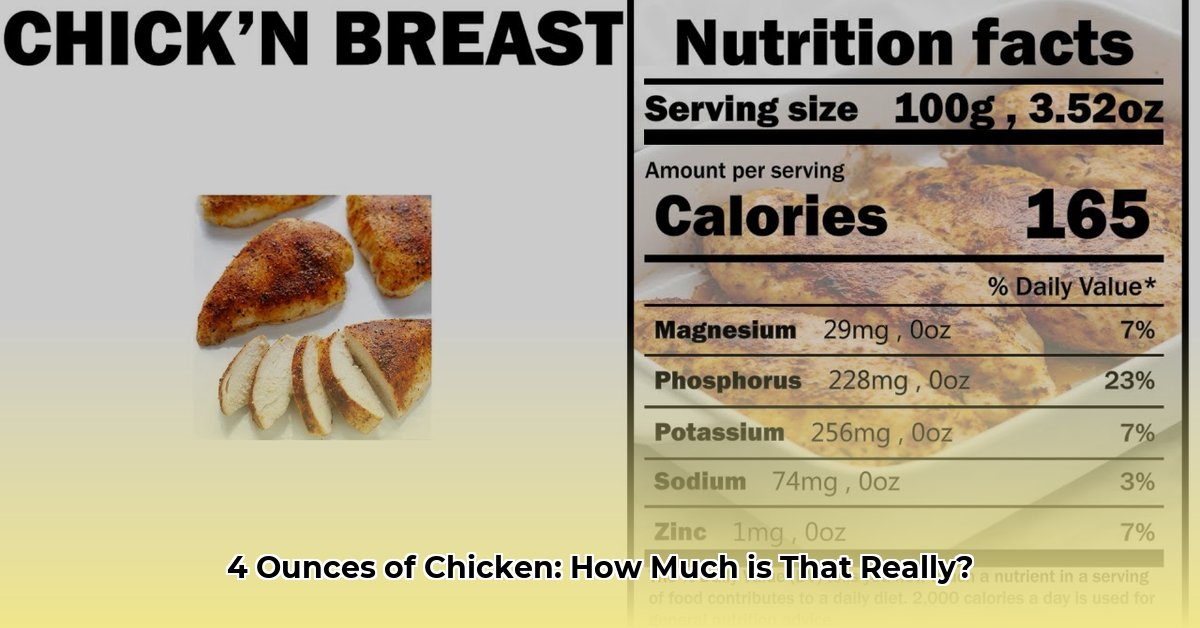Knowing how to measure 4 ounces of chicken is crucial for various reasons, from accurately following recipes to managing your calorie and protein intake. This visual guide offers practical, easy-to-use methods for estimating chicken portions without needing a scale every time.
Visualizing 4 Ounces of Cooked Chicken
Eyeballing chicken portions can be tricky. Here are a few simple ways to visualize a 4-ounce serving of cooked chicken using everyday objects:
- The Deck of Cards: A standard deck of cards is roughly the same size and weight as 4 ounces of cooked chicken.
- Your Palm: Your palm (excluding fingers) approximates a 4-ounce serving, especially for chicken breasts. This method works best for average hand sizes.
- Your Fist: A clenched fist also provides a visual estimate, similar to the palm method.
These visual cues are helpful for quick estimations, particularly when you’re in a hurry.
Raw vs. Cooked: Accounting for Shrinkage
Raw chicken loses weight when cooked due to water loss. To achieve 4 ounces of cooked chicken, you’ll likely need to start with about 5 to 5.5 ounces of raw chicken.
Portioning Different Cuts
Here’s a breakdown of approximately 4 ounces of cooked chicken for various cuts:
| Cut | Visual Cue | Ounces | Grams | Other |
|---|---|---|---|---|
| Breast | Palm/Deck of Cards/Fist | 4 | 113 | 1 medium or 2 small |
| Thighs | Palm/Deck of Cards/Fist | 4 | 113 | 1 large or 2 small |
| Wings | 2-3 Wings | 4 | 113 | ~4 average-sized wings |
| Drumsticks | 4 | 113 | ~3 average-sized | |
| Nuggets | 4 | 113 | 5-8 (size dependent) | |
| Strips | 4 | 113 | 3-5 (size dependent) | |
| Shredded | ½ cup | 4 | 113 | ½ cup loosely packed |
| Ground | ½ cup | 4 | 113 | ½ cup |
Remember, these are estimates, and variations can occur depending on the chicken’s size and cooking method.
4 oz Cooked Chicken Breast
4 oz Cooked Chicken Thighs
4 oz Cooked Chicken Wings
4 oz Cooked Shredded Chicken
Why 4 Ounces?
Four ounces is often considered a standard protein serving, offering a balance of nutrients and calories. Some health organizations, like the USDA, make this suggestion. However, individual needs vary based on factors like activity level, age, and overall health goals. Consult a healthcare professional or registered dietitian for personalized recommendations.
Rotisserie Chicken: A Special Case
Rotisserie chicken weights typically include bones and skin. When estimating a 4-ounce portion, focus solely on the meat you remove.
Nutritional Information (Approximate Values)
| Chicken Cut | Calories | Protein (g) | Fat (g) |
|---|---|---|---|
| Breast | 165 | 31 | 3.6 |
| Thigh | 209 | 26 | 10.9 |
| Wing | 203 | 18 | 14.8 |
These values can vary based on preparation methods and specific parts of the cut. Current research continually refines nutritional data, so checking updated databases is recommended. While these figures are generally reliable, it’s important to acknowledge that nutrition science is a constantly evolving field.
The Gold Standard: Using a Kitchen Scale
While visual cues are convenient, a kitchen scale provides the most accurate measurement, especially for strict diets or specific health needs. Weigh the chicken before cooking to account for shrinkage.
Tips for Accurate Portioning
- Pre-portioning: Divide raw chicken into 4-ounce portions before cooking for easier meal prep.
- Consistent Cooking: Variations in cooking time and temperature can affect the final cooked weight. Aim for consistent cooking practices for more predictable results.
Conclusion
Mastering chicken portioning empowers you to cook more accurately, manage your diet effectively, and achieve your health and fitness goals. These simple visual cues and guidelines provide a practical starting point. Remember, individual needs vary, and consulting a healthcare professional or registered dietitian is always recommended for personalized advice.
- Shop Bento Lunch Boxes on Sale Nearby Now - December 7, 2025
- Shop Bento Box for Sale To Find Your Ideal Lunch Container - December 6, 2025
- Lunch Box That Fits Bento Box Neatly for Daily Use - December 5, 2025










